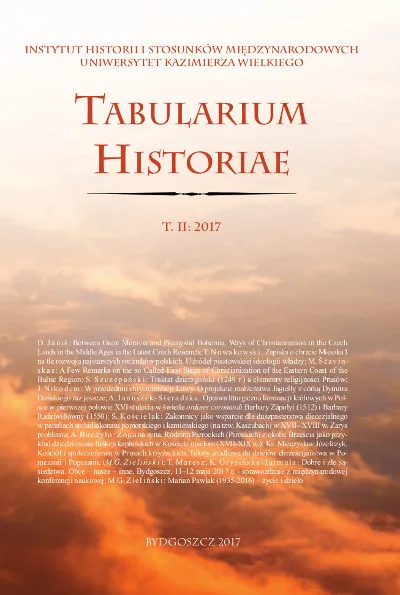Oprawa liturgiczna koronacji królowych w Polsce w pierwszej połowie XVI stulecia w świetle ordines coronandi Barbary Zápolyi (1512) i Barbary Radziwiłłówny (1550)
DOI:
https://doi.org/10.34767/TH.2017.02.06Abstrakt
Ritus et ceremoniae – rituals and ceremonies, which from the 15th century onwards have been synonymous in Europe with liturgy, very accurately define the essence of a royal anointing ceremonial not only in regard to a monarch, but also to his wife. A sacred consecration of a king’s spouse, even though a queen did not receive any power with it, gave her a sacral consolidation of her position and a distinctive legitimacy. Liturgical settings for the coronations of Polish queens is known only in broad outline from a formula preserved in the 14th century codification of the Cracow Chapter, which had used a Roman formula as its prototype, as well as from a coronation formula prepared specifically for Polish conditions on the basis of a Bohemian ordo for Elisabeth of Austria, crowned in 1454. Issue with sources from the first half of the 16th century presents itself quite differently for none of the two known at that time formulas or instructions for queens’ coronations derives, unlike their predecessors, from liturgical books, which were preserved in the sources of a “secular” provenance. Out of the four Polish queens crowned in this period – two wives of Sigismund I the Old: Barbara Zápolya and Bona Sforza, and two out of three wives of Sigismund II Augustus: Elisabeth of Austria and Barbara Radziwiłł – only two Barbaras had these specifically prepared coronation formulas. Both instructions have remained so far outside of scholars’ interests. These two instructions – drawing a particular attention to other aspects of coronation ceremonies – constitute a good mutual addition to an attempt of recreating settings for the liturgical anointing of Polish female rulers at that time. The ordo from 1512, even though written down not to the liturgical books, but to the Crown Metrics, focuses primarily on an accurate rendition of the texts of prayers and benediction, and all types of formulas voiced by the archbishop at the enthronement, but to a lesser extent on describing gestures and external circumstances of this act. The latter were presented, on the other hand, with great detail in Modus coronacionis from 1550, which focuses on gestures and demeanour, and almost thoroughly neglects the verbal surface of these rites. It seems that the lack of non-liturgical rituals at the queen’s coronation – but so elaborate, beautiful and spectacular at the king’s coronation – by no means predetermined the grandeur and significance of this church celebration. The liturgical setting of the coronations of Polish queens in the first half of the 16th century, which emphasised the uniqueness of sacrum in the coronation rite – rich in ritualised gestures, activities and words deriving from a long, European tradition, supported by a beautiful visual decoration of churches, sparkling with gold and dignified with crimson colour, highlighted by the wealth of paraments and liturgical vessels as well as the splendour and celebratory nature of liturgical vestments, undoubtedly fulfilled not only its religious, but also prestigious and propagandistic role.

